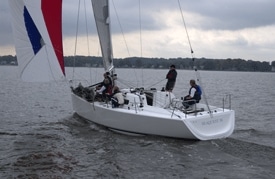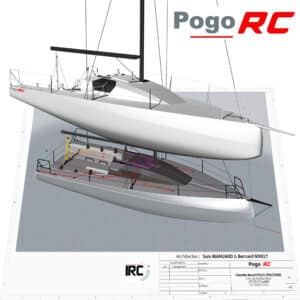
BOTY-Seaquest36
Even before boarding the Seaquest 36 for a test sail, the Sailing World judges could tell this boat is a racer first and foremost. The tall, tapered, runner-less fractional rig with swept spreaders and non-overlapping jibs, large cockpit, and tiller steering all pointed to performance as the first priority while the cockpit seats, galley, and interior showed the boat could be cruised. After sailing, the judges agreed that the Seaquest’s performance combined with efficient deck and interior arrangements, clean styling, appropriate systems and construction features rank this Reichel/Pugh-designed English import as the Best Raceboat in the 2005 Boat of the Year contest. The near vertical stem and short stern overhang contribute to a long waterline for fast sailing when in the “hull speed” regime. Beam is moderate at 10.83 feet (3.3 meters) but carried well aft so the weight of crew hiking in a breeze is effective. The entry angles of the bow are sharp, again confirming this as a racer compared to many cruiser/racers where rounder bows add fore cabin interior volume but detract from performance. While the draft of 7.17 feet (2.18 meters) might have seemed deep a decade ago, it is shallow for a racer in this era of 12-foot (3.6 meter) 50-footers. To keep ballast low, all the lead is in a bulb at the bottom, and the fin is kept thin yet strong by casting it from iron. The Seaquest 36 races IRC in the UK with a reported rating of 1.078. With many U.S. East Coast races being held under IRC this year, IRC optimized designs will be favored. The Seaquest 36’s racing design and English origins suggest this could be a boat to consider. Boarding from our chase boat, we immediately noticed easy access from the side decks to the large cockpit, access that promotes the quick and fluid crew movements that lead to good maneuvers. In our light air test sail the Seaquest 36 moved quickly upwind, sailing at just under 7 knots in 7 knots of wind. In this condition we sailed with the crew well forward, near the shrouds, and the boat seemed to like a bit of heel for best helm balance. The tiller steering provided quick response and great visibility with the helmsman seated well outboard. The Seaquest tacked quickly, accelerating up to speed shortly after tacking. Tacking angles looked good, but were difficult to judge accurately with shifty winds and in the absence of other boats. Sail handling was simple in the large cockpit with two crew on the jib forward and another on the mainsheet and traveler, aft of the helm. This arrangement, with two headsail sheet winches in the cockpit and two halyard/spinnaker sheet winches on the cabin top, has become standard for this size boat. But the cockpit size and hardware placement allowed the crew to function without bumping into each other as is common with many boats this size. The cockpit area around the companionway also worked particularly well. Here a centerline step at the same height as the cockpit seats means the crew sprinting across the boat in mid-tack doesn’t have to step down to cockpit sole level and then back up again. At other times this step provides a good grinding platform for the pit crew to work halyard and spinnaker sheet winches. Two other deck details are particularly worthy of note. Recessed foot chocks are molded into the edge of the cockpit seats to help keep the crew on the weather side but still keep the seat top horizontal at the dock. All stanchions have braces to reduce their chance of bending when either three beefy crew are pulling themselves up to the weather rail after a quick tack, or crew are thrown against them by a wave. The mainsail is the powerhouse in this boat, and it is trimmed by purchase with the coarse tune from the end of the boom to traveler. Our test boat had a fine-tune purchase alongside the coarse, but Seaquest reports future boats will have the fine-tune tackle inside the boom. Mainsail power is adjusted with the outhaul and by controlling the bend of the aluminum Hall Spars mast with shroud set-up before the race and backstay tension after the start. The traveler, easily adjusted while sitting outboard, is above the rudderpost on top of the cockpit seats. While this aft location makes it easy for the main trimmer to whisper in helmsman’s ear, the helm’s comments can be difficult to hear without him turning aft and taking eyes off sails and waves. Assuming communications issues are solved, this location works well with the rudder in the best location, under the boat as opposed to aft and ventilated when heeled, and with the main trimmer out of range of the jib trimmers’ elbows. Jib lead position is adjusted by traditional fore-and-aft tracks and, as is common in most non-overlapping jib boats, the Seaquest 36 uses jib in-pullers to bring the lead angle inboard in light air to 7 or 8 degrees and yet still have the tracks and cabin house sides outboard for increased interior volume. The standard jib tracks are short without much room for extra adjustment. The sailmaker for this boat hit the track well with the No. 1 jib we used on our test sail, but a small number 4 would have to have a high clew to still hit the front of the track. . When it came time to set the spinnaker, all went smoothly with well-placed gear. As with most boats this size, in heavy air the crew will need to think ahead in choosing which halyard to use to avoid the spinnaker sheet and halyard needing the same winch. We used an asymmetrical spinnaker in the light air knowing this boat’s speed pulls the apparent wind well forward downwind, particularly in light air. Boatspeed and jibe angles felt fine, but the judges couldn’t help but speculate how masthead spinnakers might improve the performance in light air. Our test boat carried both asymmetrical and symmetrical fractional spinnakers since IRC and now some PHRF fleets measure spinnaker area but don’t differentiate between symmetrical or asymmetrical. In addition to sailing performance, the Seaquest 36’s interior also impresses with a clean, sophisticated yet uncluttered look and not a sharp corner in sight. The combination of varnished wood furniture with molded, radiused corners, chrome and stainless hardware, and white overhead are striking when first stepping below. Immediately below the companionway to port is a chart table and navigator’s seat. Within reach just outboard is the switch panel and mounting area for radios and instruments. Opposite to starboard, the galley includes a 2-burner stove, icebox, sink and cabinets for utensils. This boat is at that difficult size, larger than the no-galley day racers yet smaller than the transoceanic racers that feed large crews for a week. The solution here is well laid out while not consuming too much space in what is primarily a race boat. The only quibble would be the relatively small size of the icebox and lack of refrigeration, probably in keeping with English vs. U.S. weather and customs for the favorite beverage temperature. Centered in the cabin is a fold-down table that serves settees on each side that are capable of seating most of the crew for a below deck meal. With the table removed, its hefty stainless steel base becomes a central grab rail and also serves to organize the racing sails stowed below decks. Seaquest makes a point of being able to sleep the full racing crew aboard, and the 36 is no exception. For use in port, there are two aft double quarter berths, a double v-berth forward and then a pair of settee berths in the main cabin whose seat backs flip up to become another pair of pilot berths. Under way, there are three usable sea berths each side of the boat counting the settee, pilot berth, and the aft double where the cushion is split with a lee canvas to keep the off watch well to weather. To starboard, between the main cabin and the v-berth, is a fully enclosed head, including sink, overhead solar vent and adequate space. Access is through a rigid door in the mast bulkhead and is tough when the starboard side of the table is up, which could cramp after-race celebrations. To port is a hanging locker and there are additional lockers outboard the forward ends of the aft berths. Light and ventilation come primarily from the three hatches. An optional pair of opening ports in the cockpit sides can be installed to better light and ventilate the aft berths. The Seaquest 36’s mechanical and plumbing systems are simple as befits a racer/cruiser where the goal is to sail and not spend time maintaining complex systems. A Yanmar 2GM20 diesel powers the boat through a sail drive. Under power engine noise was much less than some boats we tested but not silent by any means. In the flat water and light wind available for our powering test the boat accelerated well, and was easy to maneuver. Engine access for service takes a back seat in many racing boats but becomes important when the engine quits on the way to the starting line or in the middle of that multi-day race. Here the engine is under companionway steps with adequate access for service. On the boat we sailed, engine cooling water was strained only by the screen on the sail drive and not by a separate raw water strainer raising the possibility of small debris entering the heat exchanger. Removing four screws accessed the fuel filter fairly quickly, but not as easily as the tool-less systems of other boats we saw. These systems may change as Seaquest noted our test boat was one of the first off the production line and some systems have been undergoing evolutionary revisions. The electrical system includes two 12-volt batteries located midway between the panel and alternator, under the navigator’s seat. Power-saving LED interior lights are also an available option. Other systems included hot-and-cold pressure water drawing from 44-gallon tankage and a gas stove with gas bottle well in the cockpit. Construction of the Seaquest 36 is similar to some other European racer/cruisers with a solid fiberglass bottom but balsa cored topsides and deck, all hand laminated with polyester resin. Although fully cored hull shells save considerable weight and have been race proven for decades, the solid fiberglass bottom is a conservative choice that allows easier repairs should they ever be necessary. Inside the hull a massive fiberglass longitudinal and transverse beam structure spans the keel and maststep area with three transverse keel floors transferring the bending loads of the keel out to the hull sides and the longitudinal beam carrying both the rig loads induced by forestay/backstay tension and keel grounding loads. Atop this structure are molded fiberglass liners that locate the bulkheads and serve as a base for the furniture. Bulkheads and furniture are marine plywood finished either with wood veneer or attractive laminates such as the counter tops and faux teak-and-holly cabin sole. Many interior pieces such as the head enclosure are laminated of wood in curved shapes. Overhead, a molded fiberglass headliner facilitates a clean and consistent finish. Hardware is bolted through the headliner by molding solid inserts in way of fasteners and backing plates. With factors that contribute to top sailing performance including a tall rig, precise tiller steering, low-center-of-gravity keel, easy deck for sail handling, and a $198,000 price, the Seaquest 36 rates as our Best Raceboat. If you race predominately in light air, masthead spinnakers would be a plus and if you frequently sail in chop, a carbon rig is worth considering. Regardless, this IRC-influenced boat should both bring home some silver and when not on the racecourse, prove to be a racer that can be cruised.









